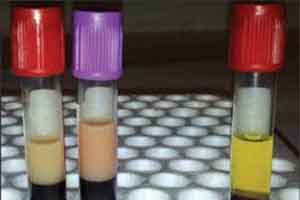Lower Prevalence of Diabetes Found Among Patients With Familial Hyperlipidaemia
 The prevalence of type 2 diabetes among 25,000 patients with familial hypercholesterolemia (a genetic disorder characterized by high low-density lipoprotein [LDL] cholesterol levels) was significantly lower than among unaffected relatives, with the prevalence varying by the type of gene mutation, according to a study in JAMA.
The prevalence of type 2 diabetes among 25,000 patients with familial hypercholesterolemia (a genetic disorder characterized by high low-density lipoprotein [LDL] cholesterol levels) was significantly lower than among unaffected relatives, with the prevalence varying by the type of gene mutation, according to a study in JAMA.
Statins have been associated with increased risk for diabetes, but the cause for this is not clear. One theory is that statins increase expression of LDL receptors and increase cholesterol uptake into cells including the pancreas, which could cause pancreatic dysfunction. Familial hypercholesterolemia causes decreased LDL transport into cells. Researchers have hypothesized that with familial hypercholesterolemia, decreased pancreatic LDL transport would lessen cell death and ultimately lead to lower rates of diabetes.
John J. P. Kastelein, M.D., Ph.D., of the Academic Medical Centre, Amsterdam, the Netherlands, and colleagues assessed the prevalence of type 2 diabetes between patients with familial hypercholesterolemia and their unaffected relatives. The study included all individuals (n = 63,320) who underwent DNA testing for familial hypercholesterolemia in the national Dutch screening program between 1994 and 2014.
The prevalence of type 2 diabetes was 1.75 percent in familial hypercholesterolemia patients (n = 440/25,137) vs 2.93 percent in unaffected relatives (n = 1,119/38,183), with adjusted figures indicating that patients with familial hypercholesterolemia had a 51 percent lower odds of having type 2 diabetes. Prevalence varied by the type of gene mutation. The researchers observed an inverse dose-response relationship between the severity of the familial hypercholesterolemia causing mutation and prevalence of type 2 diabetes.
“The small absolute difference in prevalence of type 2 diabetes between patients with familial hypercholesterolemia and unaffected relatives will not have a major influence on individual risk for type 2 diabetes. However, the substantial relative difference of 50 percent, together with previous findings, might suggest an effect of intracellular cholesterol metabolism on pancreatic beta cell function. Nevertheless, a plethora of pathways contribute to development of type 2 diabetes, and therefore, the mechanism we discuss here can only be 1 part of the pathogenesis of this highly complex disease,” the authors write.
“If these findings are confirmed in longitudinal studies, they might provide support for development of new approaches to the prevention and treatment of type 2 diabetes by improving function and survival of pancreatic beta cells.”
“What are the implications of these findings? This report adds to the growing literature of a complex interplay between lipids, glycemia, and adiposity, in which statins and other lipid-modifying agents appear to affect diabetes risk. The study also provides mechanistic insight into the potential roles of the LDL receptor and intracellular cholesterol accumulation. From a clinical perspective, the findings should allay any concerns about the potential diabetogenic effect of statins when treating patients with familial hypercholesterolemia from childhood or young adulthood given that these patients appear to be at a low risk for diabetes.”
“The study by Besseling et al contributes important evidence to strengthen the previously observed relationship between statin therapy and diabetes risk. However, this does not, and should not, alter guidance regarding the use of these important medications in patients at elevated cardiovascular risk given the clear overall benefit of statin therapy.”
Source Newsroom: JAMA – Journal of the American Medical Association
Citations
JAMA

